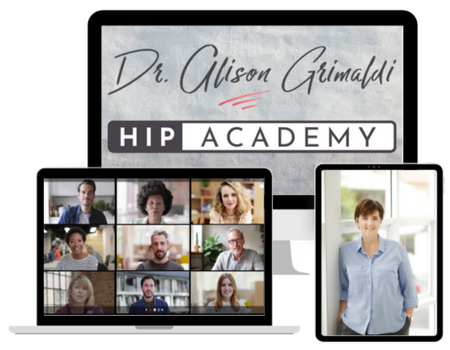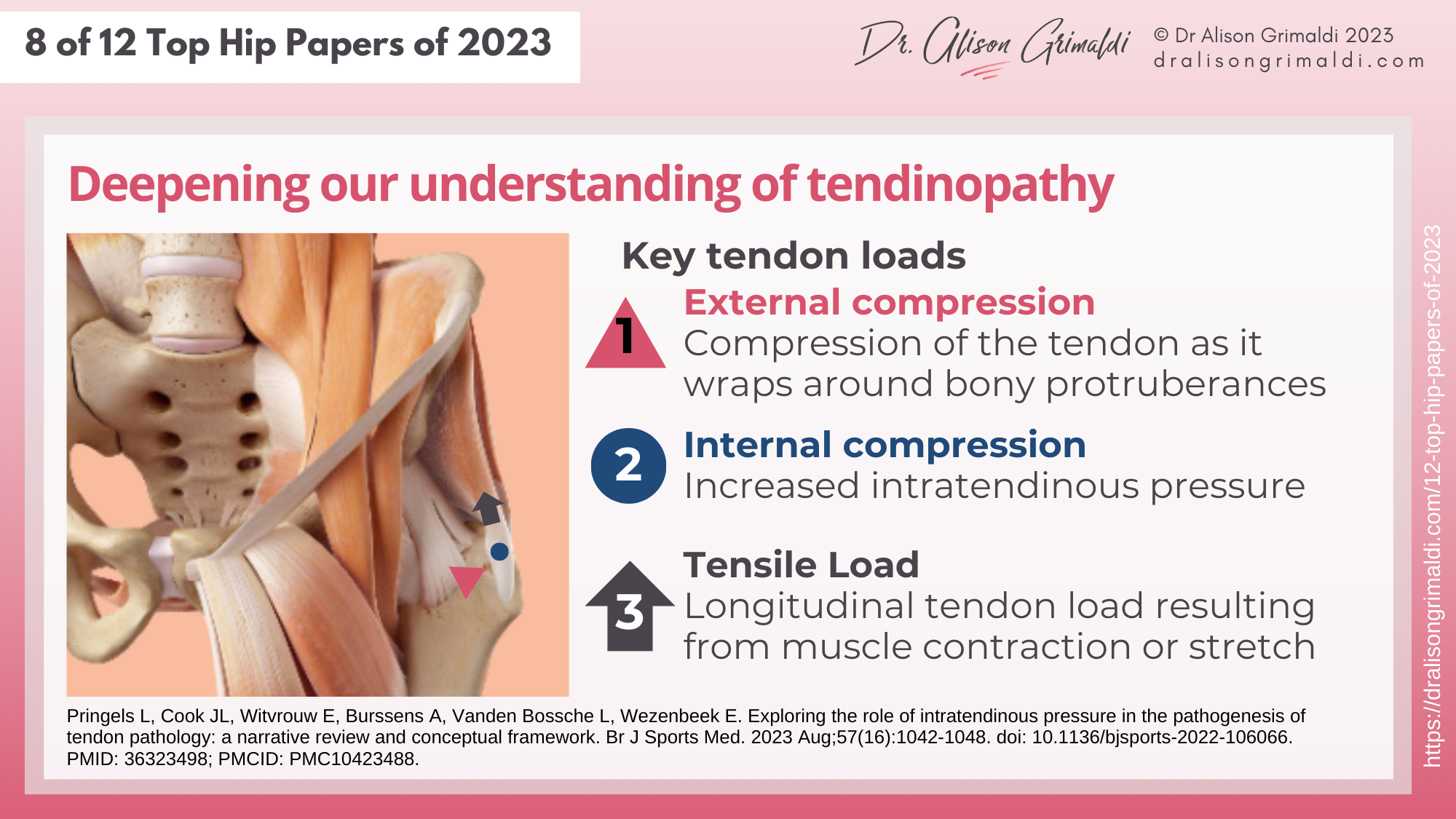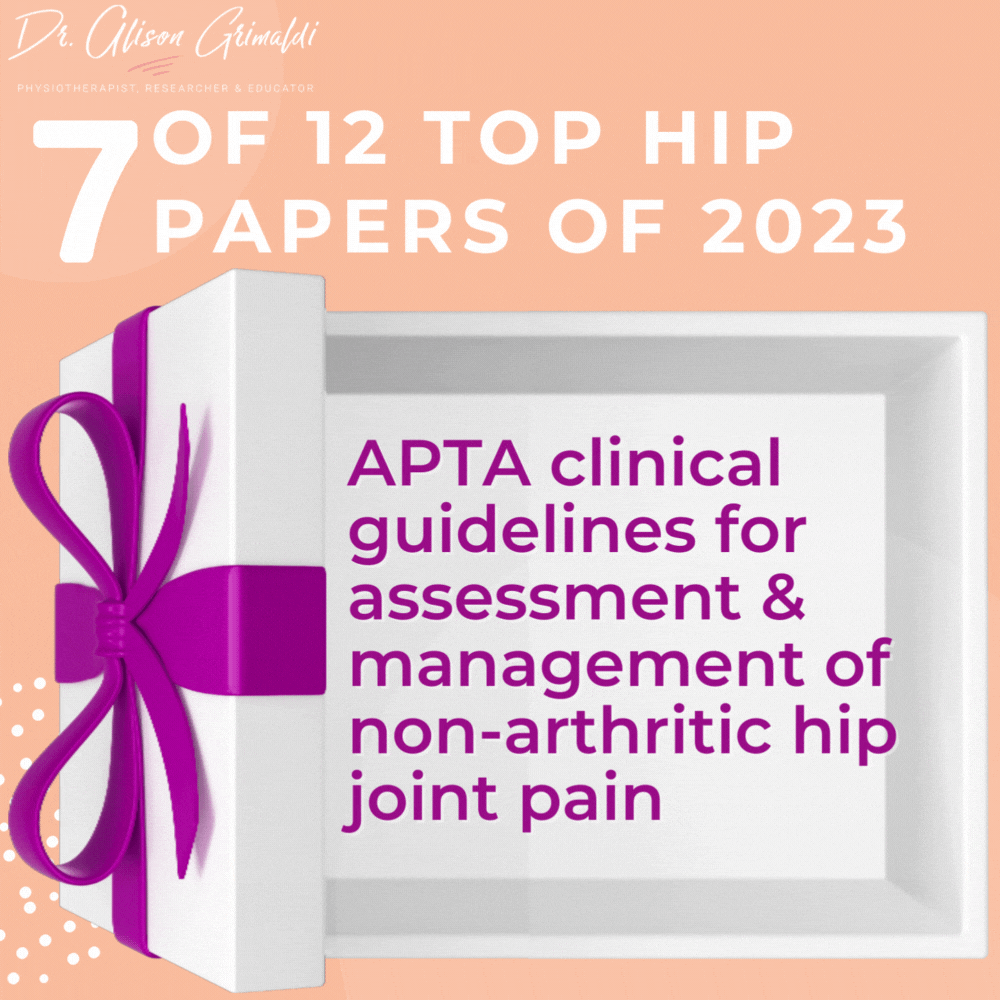8 of 12 Top Hip Papers of 2023 | Intratendinous pressure and the pathogenesis of tendinopathy

Welcome back to my 12 Top Hip Papers series of miniblogs from 2023, where I walk you through what has been happening in the hip world over 2023. We are already at Day 8! If you missed day 7, you'll find a link at the bottom of this page to take you back.
For day 8 we'll be taking a look at a new conceptual framework around the role of the role of intratendinous pressure in the pathogenesis of tendon pathology. Really interesting stuff! Read on ...

Have you heard about Hip Academy?
Enjoy the benefits of a world class educational Hip Program, specifically designed by Dr Alison Grimaldi to help improve your knowledge surrounding the Hip and Pelvis, and become an expert in your field.
With all Hip Courses included, enjoy all the extra inclusions, including; access to the entire eBook series, growing video library, expanding PDF resource centre, regular member meetings, forums + lots more!

For your convenience, we have also developed this content into a FREE 31-page full colour ebook!
Packed full of 12 Top Hip Papers - peer reviewed scientific papers from 2023, that have contributed to our understanding of hip conditions and/or the assessment or management of hip pain or injury.

8 of 12 Top Hip Papers of 2023: The role of intratendinous pressure in the pathogenesis of tendon pathology1
The role of external compression has been well accepted in the pathogenesis of insertional pathologies particularly. And it appears that this external compression tends to induce changes in tendon structure that improve the ability of the soft tissues to resist compression - laying down of large hydrophilic proteoglycans (water attracting protein molecules), expression of more cartilage type cells (good at resisting compression) and thickening of adjacent bursae and fascia e.g., the peri-trochanteric bursae and ITB in those with gluteal tendinopathy.
But this paper adds a new dimension to our understanding of tendon pathology and pain, and even more reason to ensure we are controlling excessive external compressive loading in tendinopathy.
Study Aim:
- This conceptual paper was developed to put forward some pathoaetiological considerations that have received little attention to date. The intention was to open debate to stimulate new thought and experimental research that may serve as a stepping stone for the development of novel new therapies for the management of tendinopathy.
What was done:
- A narrative review of the literature was performed and a group of tendon experts came together to expand the conceptual framework for the development of tendinopathy, to consider the role of intratendinous pressure.
The problem:
- Tendinopathy remains a major problem, for athletes and non-athletes.
- Lack of clarity about the pathogenesis of tendinopathy persists.
- High levels of tendon compression and tensile load have been implicated in the pathogenesis of tendinopathy, but our level of understanding around these processes is inadequate.
A new conceptual framework for the pathogenesis of tendon pathology:
We understand that excess compression and/or tensile load seem to be important mechanical catalysts. When we think about compression though, we are usually thinking about external compression – where the tendon is being compressed against underlying bone, either at its insertion or as it tracks around bony prominences. This new framework introduces the concept of internal tendon compression.

We know that tendon overload (excess external compression &/or tensile load) results in production of large proteoglycans and GAGs* that are hydrophilic (water attracting), resulting in a 'swollen tendon'.
But this new framework reveals that this process results in fluid getting stuck in the tendon, due to:
1. the excess water binding capacity of the large hydrophilic proteoglycans, (we knew this) but also ...
2. reduced permeability of the endo- and epitenon, ie the fascial sheaths around fascicles and the tendon actually reduce their permiability.
Excess fluid binding and reduce permiability within tendons may cause a ‘mini-compartment syndrome’, leading to adverse intratendinous processes, such as impaired vascularisation, hypoxia, leaking neovessles, pain, tendon disrepair ... sound familiar??

Clinical Implications:
So what does this new framework for the pathogenesis of tendon pathology mean for clinicians? The authors recommend a rehabilitation approach that involves load management and slow tensile loading with minimal external compression, and there may possibly be a role fro pharmacology.
- Treatments must aim to inhibit maladaptive remodelling
- load management for reducing intratendinous pressure.
- minimise external compressive load and high speed exercise while the tendon remains painful.
- Possible drug treatment that was mentioned in this paper - human recombinant hyaluronidase
- may liberate bound fluid, reducing intratendinous pressure.
- may be useful in reactive and early repair phases.
So how does this change what the rehab clinician does now. Well perhaps it should give us more pause to consider when, if and how much external compression to reintroduce to rehabilitative exercises.
Some opinion pieces on management of tendinopathy refer to the requirement to 're-adapt' the tendon to external compressive load in the later stages of rehabilitation of insertional tendinopathies like proximal hamstring tendinopathy.
But does this make sense from a mechanobiological point of view? After spending months trying to reverse some of these processes that create this 'mini-compartment syndrome', do we then want to encourage the tendon down that same path?
What the paper tells us, is that balancing external compression and tensile loads will be critical for managing internal tendon compression and health. So we need to understand the types of loads our patients' tendons are necessarily exposed to in their sports, recreation and occupations and help them best manage that with appropriate exercise and load management-recovery strategies.
If they are naturally exposed to high compressive load in their daily sport or activities, we may need to balance that with reducing unnecessary exposure to high compressive load in gym or rehabilitative exercise, and instead focusing on low compression- high tension type exercises.
And in everyday life, we may look to reduce unnecessary exposure to high compressive load, so their tendons can better manage higher compression that might be required in sport, recreation or occupational pursuits.
Something for clinicians to consider and for researchers to hopefully explore further.
Like to learn more about managing hip tendinopathies?
In this course, you can find further information on pathoaetiology, assessment and management of hip tendiopathies. To learn more, take the understanding tendinopathies of the hip and pelvis online course, or join me in a workshop. Take the anterior hip and groin pain workshop for iliopsoas and adductor related groin pain, and the lateral hip and buttock pain workshop for gluteal and proximal hamstring tendinopathy.
This online course is included in Hip Academy and Hip Academy members receive discounts for online workshops.
I hope you enjoyed the infographic and key learnings from Day 8 of my 12 Top Hip Papers of 2023. There are 4 more papers in this series, so use the navigational graphics below, to see what other top papers and infographics I have for you!

Have you heard about Hip Academy?
Enjoy the benefits of a world class educational Hip Program, specifically designed by Dr Alison Grimaldi to help improve your knowledge surrounding the Hip and Pelvis, and become an expert in your field.
With all Hip Courses included, enjoy all the extra inclusions, including; access to the entire eBook series, growing video library, expanding PDF resource centre, regular member meetings, forums + lots more!





